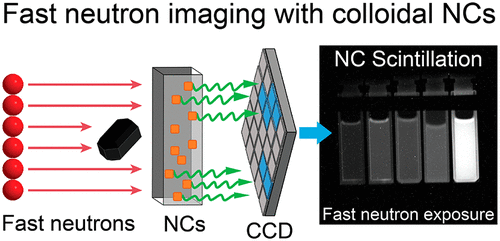Our official English website, www.x-mol.net, welcomes your feedback! (Note: you will need to create a separate account there.)
Fast Neutron Imaging with Semiconductor Nanocrystal Scintillators.
ACS Nano ( IF 17.1 ) Pub Date : 2020-09-08 , DOI: 10.1021/acsnano.0c06381 Kyle M McCall 1, 2 , Kostiantyn Sakhatskyi 1, 2 , Eberhard Lehmann 3 , Bernhard Walfort 4 , Adrian S Losko 5 , Federico Montanarella 1, 2 , Maryna I Bodnarchuk 1, 2 , Franziska Krieg 1, 2 , Yusuf Kelestemur 1, 2, 6 , David Mannes 3 , Yevhen Shynkarenko 1, 2 , Sergii Yakunin 1, 2 , Maksym V Kovalenko 1, 2
ACS Nano ( IF 17.1 ) Pub Date : 2020-09-08 , DOI: 10.1021/acsnano.0c06381 Kyle M McCall 1, 2 , Kostiantyn Sakhatskyi 1, 2 , Eberhard Lehmann 3 , Bernhard Walfort 4 , Adrian S Losko 5 , Federico Montanarella 1, 2 , Maryna I Bodnarchuk 1, 2 , Franziska Krieg 1, 2 , Yusuf Kelestemur 1, 2, 6 , David Mannes 3 , Yevhen Shynkarenko 1, 2 , Sergii Yakunin 1, 2 , Maksym V Kovalenko 1, 2
Affiliation

|
Fast neutrons offer high penetration capabilities for both light and dense materials due to their comparatively low interaction cross sections, making them ideal for the imaging of large-scale objects such as large fossils or as-built plane turbines, for which X-rays or thermal neutrons do not provide sufficient penetration. However, inefficient fast neutron detection limits widespread application of this technique. Traditional phosphors such as ZnS:Cu embedded in plastics are utilized as scintillators in recoil proton detectors for fast neutron imaging. However, these scintillation plates exhibit significant light scattering due to the plastic–phosphor interface along with long-lived afterglow (on the order of minutes), and therefore alternative solutions are needed to increase the availability of this technique. Here, we utilize colloidal nanocrystals (NCs) in hydrogen-dense solvents for fast neutron imaging through the detection of recoil protons generated by neutron scattering, demonstrating the efficacy of nanomaterials as scintillators in this detection scheme. The light yield, spatial resolution, and neutron-vs-gamma sensitivity of several chalcogenide (CdSe and CuInS2)-based and perovskite halide-based NCs are determined, with only a short-lived afterglow (below the order of seconds) observed for all of these NCs. FAPbBr3 NCs exhibit the brightest total light output at 19.3% of the commercial ZnS:Cu(PP) standard, while CsPbBrCl2:Mn NCs offer the best spatial resolution at ∼2.6 mm. Colloidal NCs showed significantly lower gamma sensitivity than ZnS:Cu; for example, 79% of the FAPbBr3 light yield results from neutron-induced radioluminescence and hence the neutron-specific light yield of FAPbBr3 is 30.4% of that of ZnS:Cu(PP). Concentration and thickness-dependent measurements highlight the importance of increasing concentrations and reducing self-absorption, yielding design principles to optimize and foster an era of NC-based scintillators for fast neutron imaging.
中文翻译:

半导体纳米晶闪烁体的快速中子成像。
快速中子由于其相对较低的相互作用截面而为轻质和高密度材料提供了高穿透能力,使其成为X射线或热成像等大型物体(例如大型化石或已建成的平面涡轮机)成像的理想选择中子不能提供足够的穿透力。然而,低效率的快速中子检测限制了该技术的广泛应用。传统的磷光体(例如嵌入塑料中的ZnS:Cu)被用作反冲质子探测器中的闪烁体,用于快速中子成像。但是,由于塑料-磷的界面以及长寿命的余辉(数分钟左右),这些闪烁板显示出明显的光散射,因此需要其他解决方案来提高此技术的可用性。这里,我们通过检测中子散射产生的反冲质子,利用氢密集型溶剂中的胶体纳米晶体(NCs)进行快速中子成像,从而证明了纳米材料作为闪烁体在该检测方案中的功效。几种硫族化物(CdSe和CuInS的光产率,空间分辨率和中子对伽玛敏感性确定了基于2)和基于钙钛矿卤化物的NC,所有这些NC仅观察到了短暂的余辉(低于秒数)。FAPbBr 3 NC在ZnS:Cu(PP)标准的19.3%处显示出最亮的总光输出,而CsPbBrCl 2:Mn NC在2.6 mm处提供最佳的空间分辨率。胶态NCs的γ敏感性明显低于ZnS:Cu。例如,FAPbBr 3的79%的光产率是由中子诱导的放射发光产生的,因此FAPbBr 3的中子特异性光产率是是ZnS:Cu(PP)的30.4%。浓度和厚度相关的测量突出了增加浓度和减少自吸收的重要性,从而产生了设计原则,以优化和培育基于NC的闪烁器时代,以实现快速中子成像。
更新日期:2020-09-08
中文翻译:

半导体纳米晶闪烁体的快速中子成像。
快速中子由于其相对较低的相互作用截面而为轻质和高密度材料提供了高穿透能力,使其成为X射线或热成像等大型物体(例如大型化石或已建成的平面涡轮机)成像的理想选择中子不能提供足够的穿透力。然而,低效率的快速中子检测限制了该技术的广泛应用。传统的磷光体(例如嵌入塑料中的ZnS:Cu)被用作反冲质子探测器中的闪烁体,用于快速中子成像。但是,由于塑料-磷的界面以及长寿命的余辉(数分钟左右),这些闪烁板显示出明显的光散射,因此需要其他解决方案来提高此技术的可用性。这里,我们通过检测中子散射产生的反冲质子,利用氢密集型溶剂中的胶体纳米晶体(NCs)进行快速中子成像,从而证明了纳米材料作为闪烁体在该检测方案中的功效。几种硫族化物(CdSe和CuInS的光产率,空间分辨率和中子对伽玛敏感性确定了基于2)和基于钙钛矿卤化物的NC,所有这些NC仅观察到了短暂的余辉(低于秒数)。FAPbBr 3 NC在ZnS:Cu(PP)标准的19.3%处显示出最亮的总光输出,而CsPbBrCl 2:Mn NC在2.6 mm处提供最佳的空间分辨率。胶态NCs的γ敏感性明显低于ZnS:Cu。例如,FAPbBr 3的79%的光产率是由中子诱导的放射发光产生的,因此FAPbBr 3的中子特异性光产率是是ZnS:Cu(PP)的30.4%。浓度和厚度相关的测量突出了增加浓度和减少自吸收的重要性,从而产生了设计原则,以优化和培育基于NC的闪烁器时代,以实现快速中子成像。



























 京公网安备 11010802027423号
京公网安备 11010802027423号